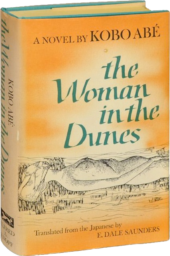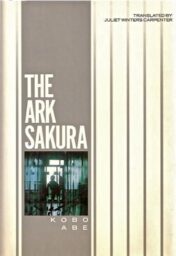Most of the magical realism and surrealism that has come into English literature from the Japanese is from Kōbō Abe (1924–1993). His slipstream novels and collections, which easily move among the various subgenres of science fiction, surrealism, and magical realism, are focused on the absurd and bewildering and were in turn influenced by Western works. One can readily note the influence of Franz Kafka and Samuel Beckett on Abe’s work, where characters are placed in bizarre situations (such as a town at the bottom of a sand pit, a confusing and nightmarish hospital, etc.) and must figure out how to adapt to their new circumstances. As Joachim Boaz notes in his review of Abe’s allegorical story “The Flood,” Abe was drawn to an avant-garde group in post-war Japan that “wanted to unify surrealism and Marxism.” Boaz writes, “In a Japan with traditional values undermined by the post-War occupation, Hanada and his followers, including Abe, wanted to craft a ‘new art’ that depicted the changing world deploying both the real and unreal, i.e., ‘a synthesis of opposites.'” For a Japan reeling from war, nuclear disaster, and occupation, such an approach to literature may have seemed like the only appropriate one.
Abe was also one of the early members of the selection committee of Hayakawa’s Science Fiction Contest, established in 1961. During his tenure (1961–1963), Abe, along with his fellow members, film producer Tanak Tomoyuki and SFX director Tsuburaya Eiji, who joined forces to create Godzilla in 1954, discovered the talents of Komatsu, Tsutsui, Mitsuse Ryu, Toyota Aritsune, Hirai Kazumasa, and Hanmura Ryo, most of whom became major writers in the first generation of Japanese science fiction. It was the insight of Abe, who kept hovering between existentialist serious fiction and hardcore science fiction, that led to the discovery of these first-generation writers, all of whom excelled at transgressing generic boundaries.
 Abe’s novel The Woman in the Dunes, first published in 1962 and translated in 1964 (the first of his novels in English), won Japan’s Yomiuri Prize for Literature. This story follows an amateur entomologist who misses his tour bus and is forced to stay overnight at the bottom of a large sand pit. Eventually, the scientist realizes that the locals won’t let him leave until he helps them shovel back the sand that threatens to engulf the village. As one reviewer notes, the “Sisyphean task” that the entomologist is given makes a larger point about human endeavor and the purpose of work. Throughout, though, we learn about various forms of discrimination in post-war Japan and the “psychologically tormenting work environment of the sarariman.”
Abe’s novel The Woman in the Dunes, first published in 1962 and translated in 1964 (the first of his novels in English), won Japan’s Yomiuri Prize for Literature. This story follows an amateur entomologist who misses his tour bus and is forced to stay overnight at the bottom of a large sand pit. Eventually, the scientist realizes that the locals won’t let him leave until he helps them shovel back the sand that threatens to engulf the village. As one reviewer notes, the “Sisyphean task” that the entomologist is given makes a larger point about human endeavor and the purpose of work. Throughout, though, we learn about various forms of discrimination in post-war Japan and the “psychologically tormenting work environment of the sarariman.”
 Abe’s subsequent texts in English are variations upon this theme of life as a surreal circle. For instance, in The Ark Sakura (1984, tr. 1988), another man is obsessed not with getting out of a place but with walling himself in. Specifically, he intends to keep himself safe in a bomb shelter, even though no nuclear disaster has occurred or threatens to occur in the near future. The Box Man (1973, tr. 1974) features an individual who pushes social norms to the extreme by giving up his identity and wandering the streets of Tokyo with a cardboard box over his head. The underworld, too, appears throughout Abe’s oeuvre as a site of psychological and physical detachment from the “real” world and a way for Abe to explore that which “realistic” fiction ignores.
Abe’s subsequent texts in English are variations upon this theme of life as a surreal circle. For instance, in The Ark Sakura (1984, tr. 1988), another man is obsessed not with getting out of a place but with walling himself in. Specifically, he intends to keep himself safe in a bomb shelter, even though no nuclear disaster has occurred or threatens to occur in the near future. The Box Man (1973, tr. 1974) features an individual who pushes social norms to the extreme by giving up his identity and wandering the streets of Tokyo with a cardboard box over his head. The underworld, too, appears throughout Abe’s oeuvre as a site of psychological and physical detachment from the “real” world and a way for Abe to explore that which “realistic” fiction ignores.
New editions of Abe in English have appeared in recent years, and introducing more Anglophone readers to Abe’s work has contributed to giving him the recognition that he deserves. As you prepare your reading list for this summer, including travel to and from Seattle Worldcon, consider including some of Kōbō Abe’s work, for Seattle is no stranger to cultural exchanges with Japan in the past or the present, continuing into the future!

